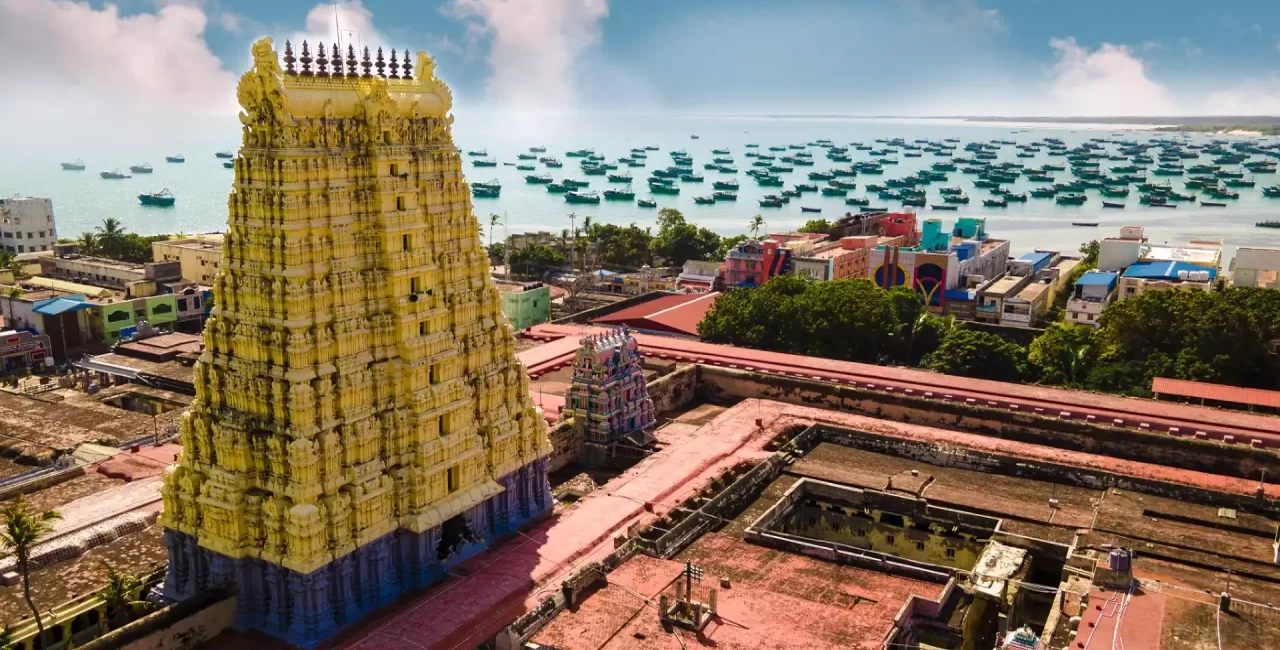Rameshwaram, located on the Pamban Island in Tamil Nadu, is one of the most sacred pilgrimage sites in India. Known for its deep spiritual significance, Rameshwaram is an integral part of the Char Dham Yatra, a pilgrimage undertaken by devout Hindus across the country. Steeped in mythology, ancient temples, and natural beauty, this coastal town offers a unique blend of history, religion, and scenic landscapes.
Mythological and Historical Significance
Rameshwaram holds an important place in Hindu mythology, particularly in the Ramayana. According to legend, it is here that Lord Rama, along with his army of monkeys and bears, built a bridge called “Ram Setu” or Adam’s Bridge across the sea to Lanka (present-day Sri Lanka) to rescue his wife, Sita, from the demon king Ravana. After his victory, Lord Rama returned to Rameshwaram and offered prayers to Lord Shiva to absolve himself of the sins committed during the war. As a result, the Ramanathaswamy Temple was built, which houses one of the twelve Jyotirlingas, making Rameshwaram a significant pilgrimage destination for Shaivites and Vaishnavites alike.
Historically, Rameshwaram has been influenced by various dynasties, including the Cholas, Pandyas, and the Sethupathis of Ramanathapuram, all of whom contributed to the development of its temples and infrastructure. The town also saw the influence of the Vijayanagara Empire and the Nayaks of Madurai, which is evident in the architectural style of its temples.
The Ramanathaswamy Temple: Architectural Marvel
The Ramanathaswamy Temple is the crown jewel of Rameshwaram. It is dedicated to Lord Shiva and is revered as one of the holiest shrines in India. The temple’s architecture is a testament to the grandeur and devotion of the rulers who contributed to its construction. With its towering gopurams (gateway towers) and extensive corridors, the temple is an architectural masterpiece.
One of the most striking features of the temple is its corridor, which is considered the longest of any Hindu temple in India, stretching over 1,200 meters and supported by nearly 1,200 intricately carved stone pillars. The temple’s large tank, or “Agni Theertham,” is another important feature, where pilgrims take a ritual bath before entering the sanctum. The temple also houses 22 theerthams (holy water tanks), each with its own religious significance.
The primary deity in the temple is a lingam, which, according to legend, was brought from the Himalayas by Lord Hanuman. However, it is believed that Sita, upon finding that Hanuman had not returned with the lingam in time for the rituals, made a sand lingam, which is still worshipped today. The temple is also renowned for its elaborate festivals, especially Maha Shivaratri, which draws thousands of devotees from across the country.
Ram Setu: A Bridge of Legends
Rameshwaram’s mythological significance is further heightened by the presence of Ram Setu or Adam’s Bridge, a chain of limestone shoals that connects India to Sri Lanka. Although there is no concrete archaeological evidence to confirm the existence of the bridge as described in the Ramayana, satellite imagery has shown a structure resembling a bridge submerged under the sea. For believers, this is the very bridge built by Lord Rama’s army, and visiting the Ram Setu viewpoint is an essential part of the pilgrimage to Rameshwaram.
This natural wonder stretches over 30 kilometers and has sparked significant interest among geologists, historians, and religious scholars. It also serves as a point of interest for visitors who want to explore the region’s mythology and natural beauty.
Dhanushkodi: A Ghost Town with a Story
Located at the southeastern tip of Pamban Island, Dhanushkodi is a deserted town that tells the story of both tragedy and beauty. Once a bustling town, Dhanushkodi was destroyed in a devastating cyclone in 1964, which left the town in ruins. The remnants of the town, including its railway station, church, and houses, can still be seen today, giving it the eerie title of a “ghost town.”
Despite its tragic past, Dhanushkodi is also significant in Hindu mythology. It is believed that after rescuing Sita, Lord Rama destroyed the Ram Setu with his bow, and hence the name “Dhanushkodi” (meaning “end of the bow”). The town offers breathtaking views of the Bay of Bengal and the Indian Ocean meeting at a point, creating a unique and peaceful setting for visitors.
Cultural and Religious Diversity
While Rameshwaram is predominantly known for its Hindu temples, the town also reflects a confluence of other religious influences. The Gandhamadhana Parvatham, a hillock that offers panoramic views of the town, has a shrine dedicated to Lord Rama’s footprints, while the Kothandaramaswamy Temple, located on the way to Dhanushkodi, is an important pilgrimage site related to Lord Rama’s coronation of Vibhishana, Ravana’s brother, after his defeat.
Another notable attraction is the Kundukal Point, where former Indian President Dr. A.P.J. Abdul Kalam’s childhood home is located. Kalam, who was born in Rameshwaram, is fondly remembered for his contributions to India’s space and defense programs. His humble beginnings and dedication to the nation are commemorated at the Dr. A.P.J. Abdul Kalam Memorial, which has become a popular site for tourists and locals alike.
Natural Beauty and Coastal Charm
Beyond its spiritual and historical significance, Rameshwaram is blessed with natural beauty. The town’s pristine beaches, crystal-clear waters, and coral reefs make it an attractive destination for nature lovers. Ariyaman Beach, located just outside the town, is a serene and less crowded alternative to other tourist beaches, offering water sports and a peaceful retreat.
The island’s coastal charm is further enhanced by its proximity to the Gulf of Mannar Marine National Park, which is home to diverse marine life and coral reefs. This park is a haven for marine biologists and conservationists, who study the region’s unique ecosystems and work towards preserving its biodiversity.
Conclusion
Rameshwaram is more than just a religious destination; it is a town steeped in history, mythology, and natural beauty. Whether you come for spiritual solace, to explore its fascinating legends, or to marvel at its architectural splendor, Rameshwaram offers a rich and unforgettable experience. From the iconic Ramanathaswamy Temple to the mysterious Ram Setu, this sacred island continues to inspire awe and reverence, making it one of the most cherished pilgrimage sites in India.


0 Comment